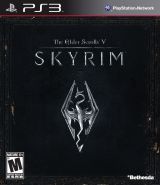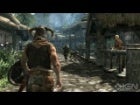
The English language itself would be hard-pressed to come up with a proper description of how impenetrable the backstory of Bethesda's Elder Scrolls universe is. We like to call it "improvisational jazz with made-up words." That's why we, Phoenix University-licensed and fully accredited Elder Scrolls historians, are taking the liberty of boiling-, dumbing-, and distilling-down centuries of phony history to the handful of hard and fast facts you'll need to know as a level-grinding tourist in the dragon-filled land of Skyrim come November. Tallyho!
The Elder Scrolls IV: Oblivion (2006)
Not to add to the potential confusion here, but we're going to start with the most recent Elder Scrolls game because it's most likely folks' point of entry for the winding series. We'll work our way backwards to beginning.

From there, obviously, the player is free to engage in a huge variety of different quests of all sorts, but the main plot follows our hero as he manages to track down and enlist the aid of an as-yet-unknown son of the Emperor, Martin, and place him on the throne. Additionally, the player must defeat the Mythic Dawn cult, their demon (or "daedra" as they're known in the Oblivion universe) masters, and ultimately a 200-foot tall Daedra Prince himself, at the cost of Martin's life, before the world is set right again.
How it was made intentionally ambiguous: Oblivion was one of the first games to offer DLC, and infamously added utterly useless digital items like barding for horses, for the low, low price of your dignity.
The Elder Scrolls III: Morrowind (2002)

The game takes place in Vvardenfell, an area populated largely by Dunmer (grey elves), who have a prophecy about a dude called the Nerevarine who will accomplish certain miracles (which the player does in a series of quests), and save the land to go on and defeat Dagoth Ur and put things right. Of course, this is exactly what happens, culminating with the player defeating a giant golem under the control of Dagoth Ur and enlisting the aid of several immortals from the Elder Scrolls world.
How it was made intentionally ambiguous: Unlike many RPGs, when you killed Dagoth Ur, the game did not end. Indeed, you could continue to play, but many things about the world, your role in it, and your level of fame, would have changed. This meant that it was difficult to know what you'd missed and how it would've been different, story-wise and gameplay-wise, had you simply done all the myriad side quests before beating the game.
The Elder Scrolls II: Daggerfall (1996)
Note: We're sidestepping An Elder Scrolls: Battlespire and Elder Scrolls Adventures: Redguard, as they're spinoffs. Battlespire was a planned expansion to Daggerfall, but was made its own separate, standalone game. Redguard is referenced marginally exactly once, later, in Oblivion, in a song a character sings. You can thank us later.

So, Uriel Septim VII gets power hungry and insists you instead hunt down the Mantella, which basically involves taking a roadtrip to the Elder Scroll's version of heaven, called Aetherius. Meanwhile, it turns out other rulers have also learned of the aforementioned correspondence and are after the Mantella for themselves, perhaps confusing it for the delicious chocolatey spread. In the end, it's up to the player to decide who to give the bloody thing to... all while Lysandus continues to torment the land of Daggerfall. Unless, you know, you choose to stop him. Which was what you were setting out to do in the first place.
How it was made intentionally ambiguous: The next Elder Scrolls game audaciously opens with an explanation that all six possible endings in Daggerfall actually happened. Simultaneously. So much for free will.
The Elder Scrolls: Arena (1994)

The only way to bring the true Emperor back is by retrieving the Staff Of Chaos' eight segments, which have been inconveniently spread over the entire world. You take on the role of a prisoner who embarks upon this glorified fetch quest, which restores order to the land. Then again, it's all for naught in the end because Uriel Septim VII meets his untimely end in a sewer in The Elder Scrolls IV -- not in the dimension Oblivion but outside of it, sidestepping any potential paradoxes.
How it was made intentionally ambiguous: Two ways, actually. First off, the game's entire world is randomly generated, suggesting there's no intention for providing consistency or continuity. Also, one screen in the intro sequence mistakenly refers to Uriel Septim VII as Uriel Septim IV. Whoops!
So there you have it. An entire fantasy universe's history condensed into 1,200 words. The Elder Scrolls: Arena is freely available if you want to experience it for yourself and see just how far gaming, and the series, has come in 15 years. But if nothing else, all these cryptic dates and foreign names have given us insight and empathy into how every immigrant must feel trying to earn their US citizenship.




